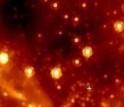|

Press Release 05-215
Clarity at the Core

New techique provides first clear picture of the center of the Milky Way
December 23, 2005
Using a new laser "virtual star" at the W.M. Keck observatory in Hawaii, astronomers have taken the first clear picture of the center of our Milky Way galaxy -- including the environs of a supermassive black hole at its very center.
"It's like getting Lasik surgery for the eyes," says team leader Andrea Ghez, professor of physics and astronomy at UCLA. "Everything is much clearer now."
The 10-meter Keck II Telescope is the first instrument of its size to incorporate Laser Guide Star adaptive optics, in which a laser-generated reference point high in the Earth's atmosphere -- a kind of artificial star -- is used to correct the atmosphere's distortions and clear up the the telescope's images.
Ghez and her colleagues, working with support from the National Science Foundation, have now used this technology to take snapshots of the center of the galaxy, 26,000 light years away.
Their findings are published in the Dec. 20 edition of Astrophysical Journal Letters.
The twin Keck telescopes, located atop Mauna Kea in Hawaii, are operated by the California Association for Research in Astronomy (CARA) on behalf of the California Institute of Technology, the University of California and NASA.
For more information, see the UCLA news release.
-NSF-

Media Contacts
M. Mitchell Waldrop, NSF (703) 292-7752 mwaldrop@nsf.gov
Stuart Wolpert, UCLA (310) 206-0511 swolpert@support.ucla.edu
Related Websites
UCLA Galactic Center Group: http://www.astro.ucla.edu/~jlu/gc/
UCLA news release: http://newsroom.ucla.edu/page.asp?RelNum=6693

The National Science Foundation (NSF) is an independent federal agency that supports fundamental research and education across all fields of science and engineering. In fiscal year (FY) 2009, its budget is $9.5 billion, which includes $3.0 billion provided through the American Recovery and Reinvestment Act. NSF funds reach all 50 states through grants to over 1,900 universities and institutions. Each year, NSF receives about 44,400 competitive requests for funding, and makes over 11,500 new funding awards. NSF also awards over $400 million in professional and service contracts yearly.
 Get News Updates by Email Get News Updates by Email
Useful NSF Web Sites:
NSF Home Page: http://www.nsf.gov
NSF News: http://www.nsf.gov/news/
For the News Media: http://www.nsf.gov/news/newsroom.jsp
Science and Engineering Statistics: http://www.nsf.gov/statistics/
Awards Searches: http://www.nsf.gov/awardsearch/
| 


